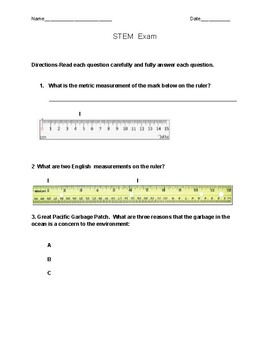STEM EXAM, STEAM EXAM Electricity, Electric Motors, Design Process
David Brown
4 Followers
Grade Levels
10th - 12th
Subjects
Resource Type
Standards
NGSSHS-ESS3-3
NGSSHS-ESS3-6
Formats Included
- PDF
David Brown
4 Followers
Description
This Mid Term or Final exam is a for the end but can be used to drive the first half of your school year. Students start with learning to measure, next they learn to draw a blue print with a 3 view point drawing title block, then we learn about electricity and electric motors and they design their own solution for the Great Pacific Garbage Patch. From Concept to finished complete model, your student will learn to use Science, Technology, Engineering and Math to its fullest. This is ONLY the exam! Enjoy!
Total Pages
Answer Key
N/A
Teaching Duration
N/A
Report this resource to TPT
Reported resources will be reviewed by our team. Report this resource to let us know if this resource violates TPT’s content guidelines.
Standards
to see state-specific standards (only available in the US).
NGSSHS-ESS3-3
Create a computational simulation to illustrate the relationships among the management of natural resources, the sustainability of human populations, and biodiversity. Examples of factors that affect the management of natural resources include costs of resource extraction and waste management, per-capita consumption, and the development of new technologies. Examples of factors that affect human sustainability include agricultural efficiency, levels of conservation, and urban planning. Assessment for computational simulations is limited to using provided multi-parameter programs or constructing simplified spreadsheet calculations.
NGSSHS-ESS3-6
Use a computational representation to illustrate the relationships among Earth systems and how those relationships are being modified due to human activity. Examples of Earth systems to be considered are the hydrosphere, atmosphere, cryosphere, geosphere, and/or biosphere. An example of the far-reaching impacts from a human activity is how an increase in atmospheric carbon dioxide results in an increase in photosynthetic biomass on land and an increase in ocean acidification, with resulting impacts on sea organism health and marine populations. Assessment does not include running computational representations but is limited to using the published results of scientific computational models.





